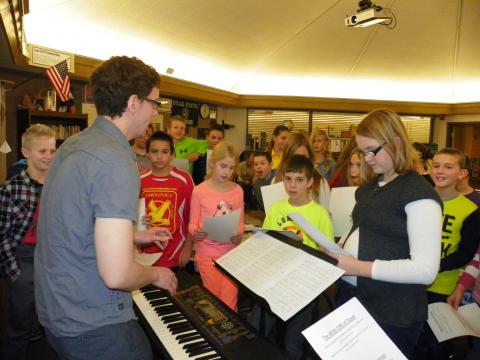
Lomond View Elementary—I arrived at the school ready to observe a class taught by the brand new music teacher, Daniel White. I made my way through the 55-year-old maze of classrooms to arrive at the far end of the school next to Alan Rhees' 6th grade class. Daniel White met me at the door with a grin and a welcome that immediately made me feel right at home. I quietly took a seat in the back of the classroom and watched as he skillfully slipped into a review of the last lesson he had taught the class. I was impressed with the ease with which these 11 and 12-year-olds popped off answers taking us on a quick ride through the events surrounding life in the U.S. immediately following the First World War. The transition between the review and the new lesson was seamless as he began playing a period song over the sound system in the background and proceeded to take the class and myself on an unforgettable journey through the Great Depression, events leading up to the Second World War, and on through the war period. He used effective questions, humor, class participation, story-telling, actions, and music to teach concepts from science and history to economy, government, and geography. Mr. White involved listeners to the point we actually felt in small measure some of the feelings people experienced during these poignant times in the history of our country. His told me his goal (and he nailed it) was to help students feel the heart and music of the period so they could gain an appreciation of what it was like. The students' home-room teacher, Mr. Rhees confirmed this when he said, "Daniel has included the historical, social, and emotional aspects of music in his lessons. The students understand well because he has integrated multiple modes of learning." After not being in the classroom for quite some time, the experience was one that took me back to memorable lessons weaving art, literature, and history together in one of my favorite classes at Weber High—Humanities—with Mrs. Keim, Mr. Frank, and Mrs. Nichols.
Mr. White is teaching at Lomond View and Valley Elementary through a grant secured by the collaborative efforts of the principals at both schools called the BTSALP grant. The grant allows core subjects to be taught in conjunction with the arts. He has a contagious excitement for the program and says, "There just isn't enough hours in the day to keep up with the demand with the teachers to come into their room. My objective is to use music to reinforce and teach the core curriculum and give teachers another way of instructing the concepts they are trying to teach." Artworksforkids.org reports that 100% of principals whose schools have participated in the program reported that it had a positive impact on their students.
Chris Boyd Brewer from John Hopkins School of Education published an article presenting some of the benefits of music in learning. Simply playing music in the background while students study, read, or write can increase attention levels, improve retention and memory, extend focused learning time, and expand thinking skills. Many studies have shown the benefits of taking it a step further and learning to read and play music, which increases reading and language skills and better enables both sides of the brain to work together. Imagine what can happen when music is integrated throughout all the core subjects!
What an amazing concept for teaching that I hope takes off in more of our schools because....why should education B 'flat' when it can B 'sharp?'
Caption: "Lomond View Elementary: 6th Graders in Mr. Rhees's class crowd around the piano to sing with music teacher, Mr. White